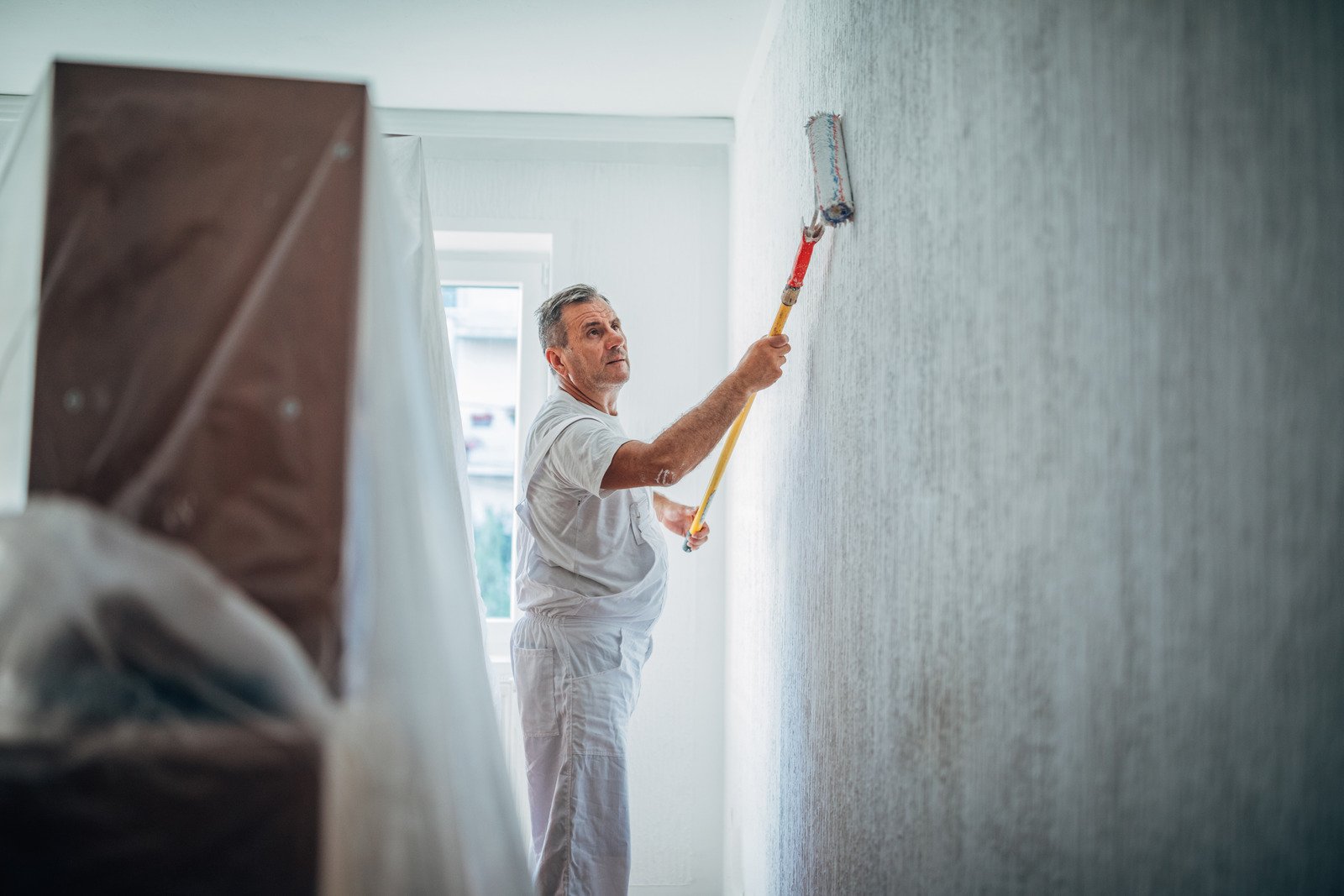One of the most important aspects to consider when trying to improve the appearance and functionality of your home’s interior is the appearance and functionality of your bathroom. This is especially true if you haven’t taken this crucial step in a long time.
When it comes to painting your interior space, whether commercial or residential, the bathroom can be a difficult place to start. There are additional factors to consider that you do not have to consider when painting other rooms.
The limited space and humidity common in bathrooms can make painting more difficult than you might expect, not to mention the soap scum, narrow cracks, and other imperfections. As a result, when painting bathroom walls and cabinets, you must take extra precautions and care.
It is common to make mistakes when painting bathrooms, which is why you need the assistance of a professional bathroom painter to get the job done right, ensuring that it lasts for a long time and functions properly.
You may be used to using bathroom painting tools like a paint roller, brush, tape, and other items on your own. Professional painters, such as The Ohio Painting Company, will use the expertise and equipment of highly-trained personnel and cutting-edge technology to improve the appearance of your bathroom through a flawless interior painting job.
Bathroom Painting Tips
Here are some tips from The Ohio Painting Company if you want to paint a bathroom on your property.
Begin With the Ceiling
Painting a bathroom is more than just picking up a brush and getting started. There are several steps to take. Starting from the top is the best way to avoid having to redo the job. Begin painting from the ceiling and work your way down. Use a brush to paint in and around the corners of the ceiling. Finish with a pole and a paint roller at the end. To get the most out of this, choose a high-quality, lush roller cover. It is beneficial to apply as much paint to the ceiling as quickly as possible.
The procedure entails dipping the roller into the paint tray and rolling it up to remove excess paint. Maintain a wet roller and paint over the edges to ensure they are even. Latex paint is ideal in this situation because it dries quickly. After at least four hours, you can add a second layer.
To ensure even coverage, paint the first coat in one direction and the second in the opposite. For example, paint the first one from west to east and the second from north to south. Using a brush, try to cut the tight edges.
Paint the Bathroom Trim Before the Walls
Use an angled brush to paint the bathroom trim and baseboards. This allows you to avoid the difficult task of taping the walls. Applying tape to the trim should be much easier this way. For bathroom trims, semi-gloss paint is ideal. It is especially effective on chair rails, baseboards, doors, and window trims, which collect the most dirt and dust. Semi-gloss paint is easier to clean and lasts longer than other finishes.
In most homes, the most common color for bathroom trim is white. If the current paint is white, you can choose another color. If you’re a creative person, you can go with blue, black, or grey.
Prime the Walls
Priming the bathroom walls is recommended after changing the color or patching them. If you are not making any repairs or making drastic color changes, use self-priming paint. It is best to prime if your new paint is lighter than your old one. When priming, use the same technique as when applying a top coat. Brush the edges before applying the borders with a roller.
Patch Cracks and Holes
Patching cracks and holes is a necessary step before painting. You can direct a bright light over the walls to see them clearly. Patch the problem areas with a putty knife and scrape away the excess mixture to leave a smooth surface. Fill in any nicks or holes in chair rails and baseboards with wood filler.
The same method can be used to trim around doors and windows. Depending on the drywall or filter compound, drying time can range from six to twenty-four hours. After that, sand the surface with 320-grit sandpaper until it is as smooth as the surrounding surface.
What are the best brushes to use?
Use an angled brush to paint around the edges of the wall. Dip it in paint, tap off the excess, and cut it about 1.3 centimeters from the edge of the wall. When painting back to the trim, take care not to go beyond the edge of the wall. To avoid lines, only paint along the edges of the wall and finish with a roller.
Only paint one section of the bathroom wall at a time. This ensures that you are always painting over damp paint and that lap lines do not appear. When you start rolling the roller over the remaining wall after painting the trim around the room, it will be dry.
Finishing
It takes at least 24 hours for the paint to dry. After that, you can update your bathroom by replacing the curtains, socket covers, and wall art. Cut along the trim’s edges with a utility knife and pull it back. Remove the paint from the wall that has bonded with the tape by peeling it off without cutting it. Remove the fixtures’ coverings and drop cloths and store them for future use.
It is now time to replace the toilet, if necessary, and re-connect the water supply. Showering should be avoided for at least 24 hours.
Common Mistakes to Avoid
There are several mistakes and oversights to avoid when painting your bathroom. They are as follows:
Insufficient Preparation
It is critical to thoroughly prepare your bathroom walls before painting them. Professionals advise that this procedure should take twice as long as the paint job. Taping the counters and pipes makes a big difference in the end result.
Allow plenty of time to tape tiles, wrap doorknobs, and remove all wall plates. This ensures that you are at ease when performing difficult tasks. Shimming inside and around showers and painting the back of the toilet tank are two examples.
Another common preparation mistake is washing the walls. Bathroom walls are notorious for collecting a lot of dust and grime. Vacuum up the dust and wipe away the grime with a good de-greaser. A common home remedy consists of two cups of vinegar and approximately 1.5 liters of warm water. Wash the walls thoroughly with a sponge, paying special attention to the baseboards and tight corners.
Forgetting the Primer
Primer is useful for all types of painting, but it is especially important for bathroom painting. Ignoring this can have far-reaching consequences for your paint job. Primers aid in the smoothing of the surface of your cabinets. They also aid in the proper adhesion of the new paint to the walls. Oil-based primers conceal old stains and revitalize the surface.
Purchasing the incorrect paint
The atmosphere in your bathroom is unlike that of any other room in your home. Because of the constant presence of water and steam, it is frequently damp. As a result, resist the urge to buy regular paint. The ideal bathroom paint should be mold, mildew, and water-resistant. Choose one with a mildew-resistant additive and a semi-gloss, satin, or gloss finish. The sheen finish in the paint acts as armor, protecting the walls from water damage.
Being Frugal on Paint
Nobody wants to start painting and then stop to get more supplies. Rushing the job can also result in streaks and uneven areas on the walls. Some computer tools can assist you in selecting a color, but they cannot match the old one. It is common to purchase less or more paint. According to experts, the best ratio to use when planning a paint job is two liters of paint per 400 square feet.
Rushing to the second coat
Allow enough time for the first layer of paint to dry before applying the second. Rushing to apply another coat can result in a variety of problems. The underlying layer may peel away, revealing streaks and holidays. Wait at least 24 hours after finishing the first layer before proceeding. One of the most common mistakes in bathroom painting projects is rushing to apply a second coat.
Using regular brushes
Paint brushes are available in a wide range of shapes, sizes, and textures. A paint roller is the best option to cover the majority of the walls. They are the most effective way to achieve an even coat. When using a paint roller, you can use a variety of techniques. Start with a W motion and fill in the rest in a similar format to achieve even coverage. When it comes to bathroom wall detailing, brushes are essential.
Using low-cost tools may help you save money, but it may also harm your results. Select the appropriate brushes for the type of paint. When working with oil-based paints, use a natural paint brush; when working with latex paints, use a brush with synthetic bristles.
Not Taping
A paint job that is not taped can look untidy and messy. You must work extra hard to ensure that there are no paint smudges in areas that you do not want. Taping can assist you in establishing borders that will guide you when painting. If you accidentally paint over the border, the painter’s tape will protect the area. Remove the tape after finishing the project to reveal a nice paint job.
Improper Ventilation
It is critical to keep your bathroom well ventilated while painting it. Failure to do so is hazardous to your health and ensures that the paint does not dry properly. Paints emit strong odors and contain chemicals that are hazardous to human inhalation.
Forgetting to Remove Barriers
Removing any clutter in your bathroom that may interfere with your painting process is key. Before you begin, remove all electrical covers, bathroom products, window treatments, towel racks, shelves, and wall art. To avoid losing the screws, remove the wall switch covers and electrical outlets and store them safely. You can also remove or cover the door or cabinet knobs.
Not Covering Floors and Fixtures with Drop Cloths
Many people appear to be unaware that painting can be messy. Cover any surfaces or fixtures that you are unable to remove. Canvas is the best floor material because it is heavy and has better traction than plastic. It absorbs paint spills, making it difficult to track paint onto other areas of the job site. For added security, lay down a plastic sheet before laying down the canvas drop cloth.
Hire the Best Bathroom Painters in Cincinnati, OH
Look no further if you need a skilled bathroom painter in Cincinnati or the surrounding suburbs and cities. The Ohio Painting Company employs the most qualified and certified painters in the area. We are a family-owned Ohio company with an unrivaled reputation for bathroom painting and other services. We also specialize in all aspects of making your home feel comfortable and functional.
Because your bathroom is one of the most used rooms in your home or office, our professionals go above and beyond to ensure that your bathroom painting project is completed correctly the first time. We also make certain that your bathroom has the best aesthetics to match your preferences and needs.
Visit The Ohio Painting Company in Cincinnati, OH for more information on bathroom painting tips and common mistakes to avoid. You can also schedule an appointment by calling (937) 409-4443. We will answer all of your questions and walk you through the process of painting every room in your home.






